#simplified chinese
Text
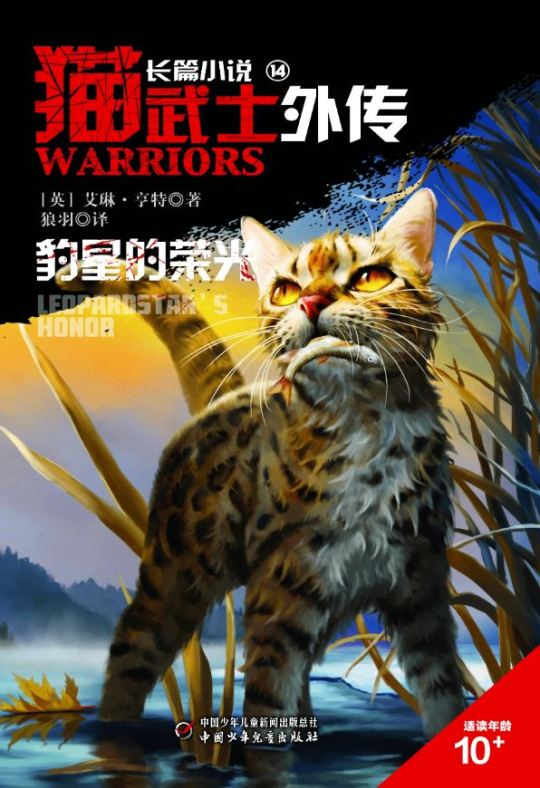
Title: Leopardstar's Honor
Arc: Super Edition
Type: cover
Country: China
Characters: Leopardstar
Source: https://warriors.fandom.com/wiki/Leopardstar%27s_Honor
148 notes
·
View notes
Text
Random Stuff #12: What is Simplified Chinese?
For people like me who grew up speaking and using Chinese in day to day life, the vast majority of us have at least a basic understanding of what Simplified Chinese is, but it wasn’t until some days ago when an English speaker asked me “what is Simplified Chinese?” that I realized not many people here understand what Simplified Chinese is. So, I’ve gathered some misconceptions I’ve encountered both in real life and online, and I will try to answer them in a concise but factual manner.
But first, let us talk basics. There are three things we must cover first before going into this topic. The first is the fact that both Simplified Chinese (简体中文) and Traditional Chinese (繁體中文) used today are modern standardized systems of written Chinese, as in both were compiled within the past 100 years or so (modern Simplified from 1935-1936, then again from 1956 and on; modern Traditional starting from 1973), and the two currently widely used versions of both systems were officially standardized in the past 50 years (modern Simplified current version standardized in 2013; modern Traditional current version standardized in 1982). However, since simplified characters already exist in history (called 简化字/簡化字 or 俗体字/俗體字/”informal characters”), and “Traditional Chinese” can be taken to mean “written Chinese used in history”, in this post I will use “modern Simplified/Traditional Chinese” or “modern Simplified/Traditional” when referring to the currently used modern standardized systems.
Second is the evolution of written Chinese. Usually when this is taught, instructors use examples of how certain characters evolved over time, for example one might encounter a linear diagram like this in Chinese class:

(Original picture from Mandarinpedia)
However, this diagram only gives a very general idea of how characters evolved from more picture-like logograms to the more abstract symbols we call characters today, and does not reflect the complexity of this evolution at all. To get into these details we will need to talk about Chinese calligraphy. In terms of the evolution of written Chinese, Chinese calligraphy--all those scripts like oracle bone script (甲骨文), bronze/Jinwen script (金文), Seal/Zhuan script (篆书/篆書), Clerical/Li script (隶书/隸書), Regular/Kai script (楷书/楷書), etc--they aren’t just calligraphy fonts, but actually change the way characters are written, and are representative of the commonly used forms of written Chinese at different points in Chinese history, as in the appearance of a certain script on a historical artifact can actually be used to estimate how old the artifact is. Below is a (very) rough timeline of when each script appeared and when they are most popular:
Oracle bone script/Jiaguwen (甲骨文): Shang dynasty (~1600 BC-1046 BC)
Bronze/Jinwen script (金文; includes Large Seal script/大篆): Western Zhou dynasty (~1046 BC-771 BC)
Seal/Zhuan script (篆书/篆書; sometimes called Small Seal script/小篆 or Qin script/秦篆): compiled in Qin dynasty by chancellor Li Si/李斯 around 221 BC, was the official script in Qin dynasty (221 BC-207 AD); popularity went down after Qin dynasty but was still in use for ceremonial purposes like official seals (the archaic meaning of 篆 is “official seal”, hence the English name); still in use today in very specific areas like seal stamps, calligraphy, logos, and art.
Clerical/Li script (隶书/隸書): appeared in Qin dynasty, became the main script used in Han dynasty (202 BC-220 AD); popularity went down after Han dynasty but was still in use; still in use today in specific areas like calligraphy, inscriptions/signatures on traditional Chinese paintings, logos, and other art.
Regular/Kai script (楷书/楷書): appeared in late Han dynasty, became the main script used in Tang dynasty and has been popular ever since (618 AD-present).
(Note: there are other calligraphy scripts like Semi-Cursive script/行书/行書 and Cursive script/草书/草書 that were never mainstream yet were also significant, especially in the case of modern Simplified Chinese, but I will mention them later so this won’t become too confusing)
So if we plug the information from the very rough timeline above into the linear diagram, it becomes this:
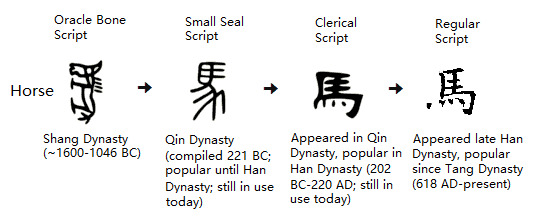
But wait! There’s even more! Because there is a thing called variant Chinese characters/异体字/異體字, which basically means that there have been multiple ways in which a character can be written (“one character, many forms”/一字多形), and these can come about as a result of homophones, personal preference of historically significant people, historical trends, mistakes in the past that stuck around, or the result of stylized scripts like Cursive script/草书/草書, which simplifies and connects strokes in a liberal manner. The reason Cursive script is important here is because of the logographic nature of written Chinese, meaning the simplifying or connecting of strokes actually changes how the character is written. Because of this, 马 and 馬 were forms that have already existed before modern Simplified and modern Traditional were compiled. A diagram that takes variations and evolution into account should look something like this:
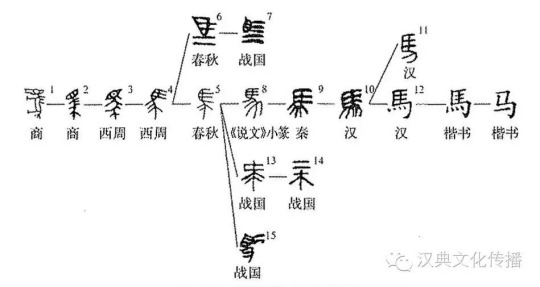
And since the above diagram did not take Cursive script into account, here’s another picture of a myriad of scripts/fonts (not in chronological order) that includes 馬 in Cursive script (mostly on bottom left):
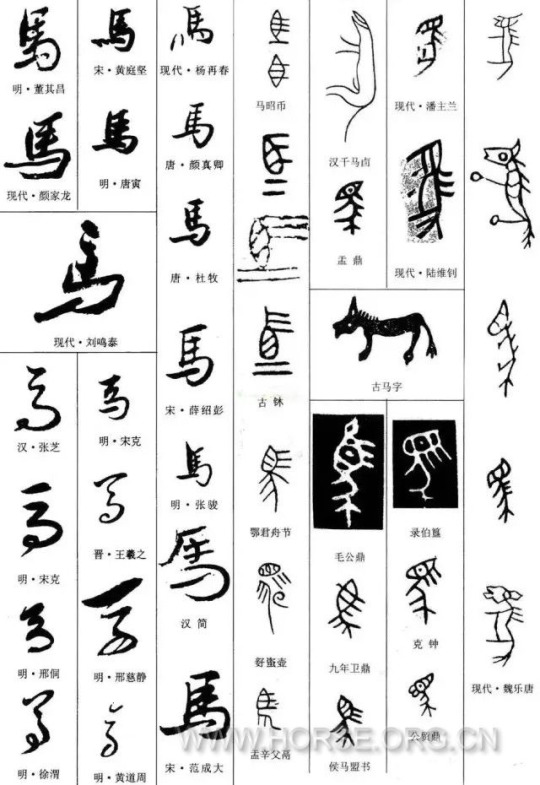
Now you may have an idea of where modern Simplified and Traditional Chinese came from: they are both compiled from existing variants. Since both modern Simplified and modern Traditional are supposed to be standardizations of written Chinese, they each set a single variant for each character as the “standard”. Modern Traditional Chinese kept the more historically mainstream 馬, and modern Simplified Chinese substituted it with the simpler variant 马. Taking all of this into account but still keeping it concise for our topic here, our linear diagram from the beginning should be modified to look like this:
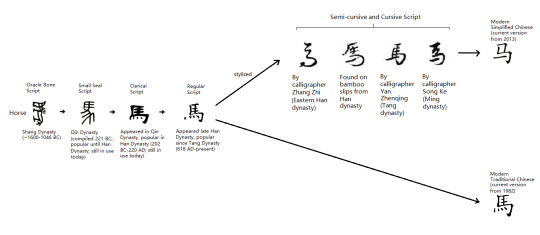
And that’s just an example of a single character. This evolution diagram can differ depending on the character too, due to there being other rules for simplifying characters. This is why standardizing written Chinese is an immense amount of work, but once standardized, the written language will be streamlined and much easier to use in communication.
Finally, we are ready to clear some misconceptions.
---------------------------------------------------
About Common Misconceptions Regarding Modern Simplified Chinese:
“Simplified Chinese replaced all Traditional Chinese characters”. Untrue. Modern Simplified Chinese only standardized 2274 of the most used Chinese characters and 14 radicals with simpler variants. That’s really all there is to it. For reference there are a total of about 60,000 Chinese characters, and about 3,500 of these are deemed to be often-used characters; so only ~3.7% of all Chinese characters and ~65% of often-used Chinese characters are simplified in modern Simplified Chinese. Play around with any online tool that can switch between modern Simplified and modern Traditional, and you will find that many characters stayed the same.
“Simplified Chinese is the opposite of Traditional Chinese”. Untrue. Modern Simplified Chinese is just a simplified and standardized system of written Chinese. Modern Simplified Chinese and modern Traditional Chinese are not “opposites” of each other at all, just different standardized systems serving different purposes. Modern Simplified was compiled with ease of use in mind, since Traditional characters can be time-consuming to write, for example imagine writing 聲 (sound) when you can just write 声 instead. Also back when Simplified was being introduced to the public, a huge part of the population was illiterate, especially farmers, poor people, and women, so Simplified Chinese was a great way to quickly educate them on reading and writing, and to improve efficiency in all aspects of life. Knowing how to read and write is key to education, and education is a must if people's lives were to be improved at all.
“Simplified Chinese is Mandarin”. Untrue. Mandarin is a spoken dialect that came from Beijing dialect, and both modern Simplified and modern Traditional Chinese are modern standardized systems of written Chinese. One concerns the written language and the other concerns a spoken dialect.
"Simplified Chinese was invented by the Communist Party". Untrue. As mentioned before, most characters used in modern Simplified Chinese are already present in ancient texts, artifacts, and inscriptions as variants. Apparently the only character simplified by PRC was 簾 (blinds/curtain), which became 帘 in modern Simplified Chinese. History wise, Republic of China was the first to start compiling Simplified Chinese in 1935 and introducing it to the public, but this was called off after 4 months. PRC modified and built on the original plan, and introduced it to the public again starting from 1956.
"Simplified Chinese is to Traditional Chinese as Newspeak is to English in 1984". Completely untrue. Modern Simplified Chinese is just a simplified way to write commonly used Chinese characters and does not alter the meaning of the characters. There are some Traditional characters that are combined as one simplified character in modern Simplified, but the meanings are not lost or altered. For example, 發 fā (development) and 髪 fà (hair) are combined as 发 in modern Simplified, resulting in 发 having 2 different pronunciations (both fā and fà), and each of these pronunciations carrying their original meaning. The meaning of neither 發 nor 髪 was lost, 发 will just have a longer dictionary entry.
"Simplified Chinese is a huge change from Traditional Chinese". Only partly true in that it is a change, but it is a change justified by the evolution of written Chinese throughout history. The origin of most modern Simplified Chinese characters come straight from history itself, since many characters had alternative ways in which they were written (sometimes for convenience), for example these characters below. Each row contains different forms of a single character (smaller characters indicate what time period these variants are from; ex: 汉碑 means the variant is from a Han dynasty inscription).
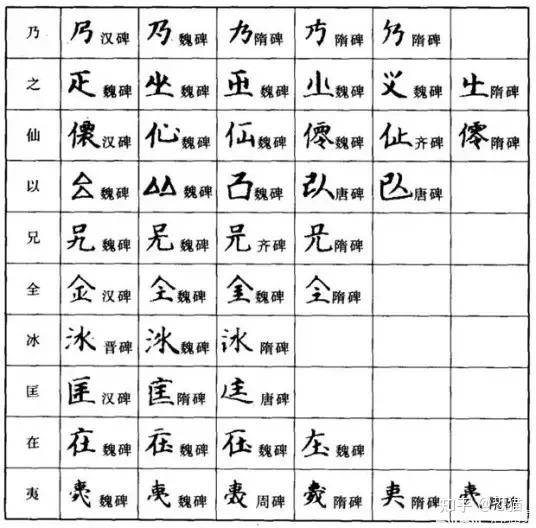
In reality, written Chinese has always been standardizing itself. Less-used variants become forgotten over time, sometimes only rediscovered through archaeology. Besides, effective written communication does partly rely on standardization of the written language (imagine everyone writing in the various variants...how horrible would that be?). Modern Simplified just took this one step farther and made some characters easier to write.
“Traditional Chinese is no longer used in Mainland China”. Untrue. Modern Simplified is the commonly used form in Mainland China, but Traditional is still used in a variety of places, such as on store signs/brand logos, particularly for stores/brand that are old. For example the old Beijing brand 天福号 below (est. 1738). On their logo, 天福号 is written as 天福號 from right to left, which is the traditional way of writing horizontally.
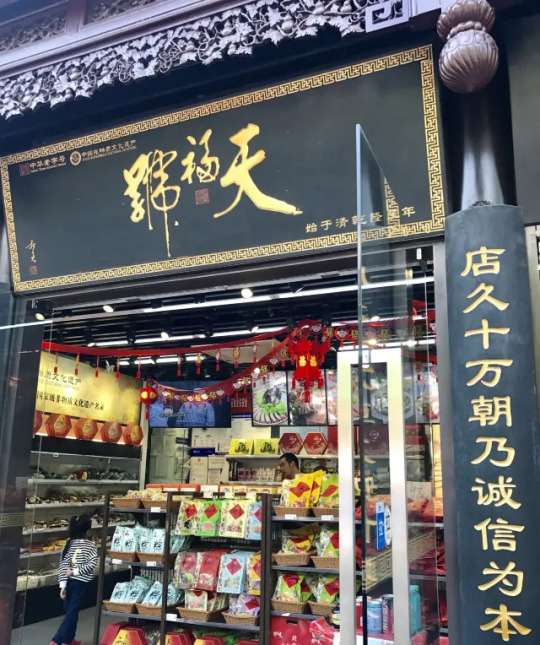
Traditional Chinese is also used in the logos for many universities in China:

Another way in which Traditional Chinese is commonly used in mainland China are personal seal stamps. Often times when people carve seal stamps for personal use (for example showing ownership on artwork they created or collected), they would put their name/courtesy name/nickname on the seal stamps in Zhuan/篆 calligraphy font, and Zhuan font use Traditional Chinese. Of course, the ways in which Traditional Chinese is still used in mainland China isn’t restricted to these two examples here. There are other places where Traditional Chinese is still used, such as traditional paintings/国画, calligraphy/书法, and many many more.
“People who grew up reading Simplified Chinese cannot read Traditional Chinese”. Depends on who you are asking. I grew up learning only modern Simplified, and I can read Traditional/modern Traditional Chinese just fine without having to actually learn it from anyone. Most people who grew up with Simplified Chinese should be able to read at least some Traditional without help. There are some people who say they can’t read Traditional without taking the time to learn it, but I doubt they’ve really tried, to be very honest.
---------------------------------------------------
And that’s it for the misconceptions!
My personal philosophy regarding modern Simplified Chinese and modern Traditional Chinese can be summed up as 识繁写简, or basically “know how to read Traditional and know how to write Simplified”. In a way, knowing how to read Traditional is a bit like knowing how to read cursive: a lot of history could be lost if we completely stopped using/learning about Traditional Chinese, but to meet the fast pace that modern life demands, I think modern Simplified Chinese is the more convenient choice for writing for day-to-day purposes. Since quite a few posts on this blog concern history, you will find that I usually use both Traditional Chinese and Simplified Chinese for historical things, since modern Traditional Chinese is closest to what people used in the past, and modern Simplified Chinese is more often used now. If it appears that I didn’t put modern Simplified and modern Traditional side by side, that usually means either the characters stayed the same and there’s no need for me to type the same thing out again, or the topic does not call for both to be shown.
Finally, the fun part. Here’s a Seal/Zhuan script calligraphy work by Mi Fu/米芾 (1051-1107):

Does something look familiar there?
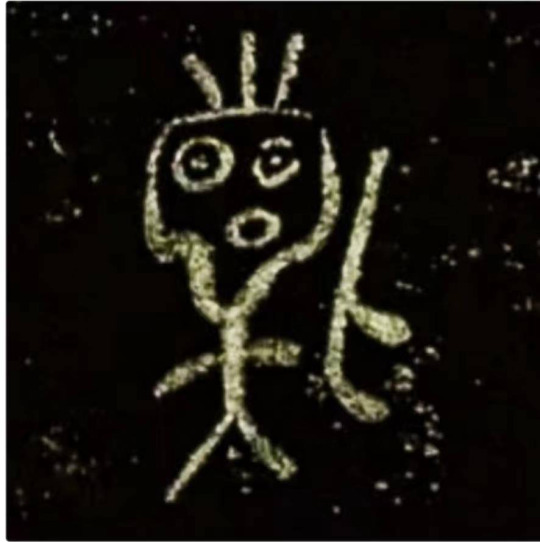
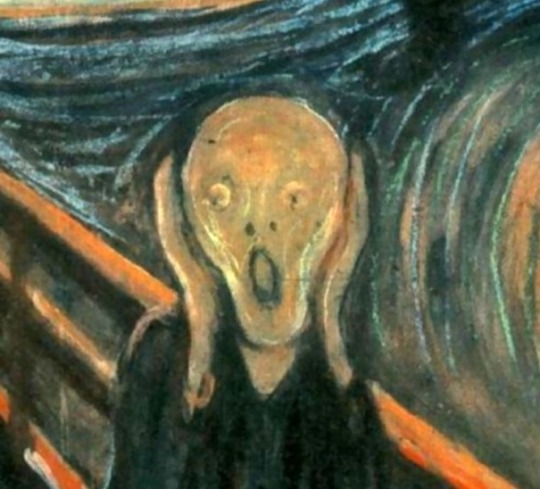
#simplified chinese#chinese language#language#written language#traditional chinese#chinese calligraphy#chinese history#random stuff#what is simplified chinese
990 notes
·
View notes
Text
Was in the middle of reading a fic when I was completely blindsided by “Mandarin people”. Referring to Chinese people who speak Mandarin. I was absolutely flabbergasted like what? I already die inside when people refer to the written aspect of Cantonese as that instead of Traditional Chinese (please, Cantonese is the dialect, not the characters. And on that vein, Mandarin is also a spoken language and its written form is Simplified Chinese because Canto is the OG) but this just took the cake. Mandarin is a language (technically a dialect too but who’s nitpicking) not a nationality?
Also there are different terms for paternal and maternal sides of the family and it is driving me absolutely crazy to see “Yéye” (爷爷: paternal grandfather) and “Năinai” (奶奶: paternal grandmother) used for mother’s parents. “Wàigōng” (外公) and “Wàipó” (外婆) are for maternal grandfather and grandmother. Literally translated, it means “outside grandfather/mother”, but the 外 (wài: outside) is often omitted and the last character is repeated to just “Gōng Gōng” and “Por Por”.
#rant#sort of psa#yes this was a maydaisy fic#no hate tho#it’s just genuinely driving me crazy#I appreciate the Chinese culture incorporation but pls ftlg do it right#it kills me inside every time I see the wrong name for grandparents#I rejoice when it’s right tho#like thank you for doing your research#Chinese things#traditional Chinese#Chinese language#Cantonese#mandarin#simplified Chinese
32 notes
·
View notes
Text
Things I've learnt since changing my phone to Simplified Chinese:
关注 (guān zhù): to follow
屏蔽 (píng bì): to block
举报 (jŭ bào): to report
22 notes
·
View notes
Text
I bought vol1 of The Hunger Games and Alice's Adventures in Wonderland in simplified Chinese. They will definitly be above my level but I think they will be hugely motivating. I heard when reading something in Chinese you should start with stories you're familiar with, and I was really struggling to find something online. Especially for free. I wasn't even trying to find these books or this store. The store was just on the street I was walking down while shopping with friends, and the books were super affordable!
Anyway incase anyone is curious here are their titles in Chinese
饥饿游戏; jī'è yóuxì; hunger game; The Hunger Games
爱丽丝漫游奇境记; Àilìsī Mànyóu Qíjìng Jì; Alice, to roam/travel around, wonderful, area, remember; Alice in Wonderland
i don't know if my literal translation of 爱丽丝漫游奇境记 is correct
#mandarin#chinese#simplified chinese#learning chinese#correct me#language learning#The Hunger Games#Alice in wonderland#饥饿游戏#爱丽丝漫游奇境记
6 notes
·
View notes
Text
Filia handwritten name. Ordered from jasonl_31 on fiverr.
Simplified Chinese
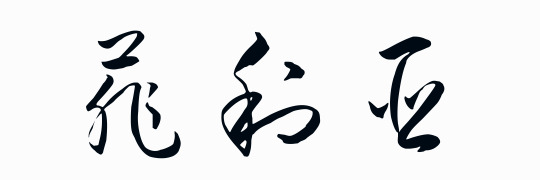
Japanese
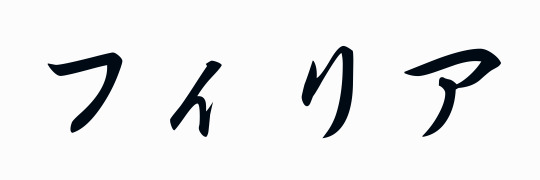
#skullgirls filia#skullgirls#filia medici#handwritting#chinese calligraphy#calligraphy#japanese calligraphy#jasonl_31#commissioned art#Simplified Chinese#Japanese#artist support#support artists#support small artists#フィリア#フィリア・メディチ
0 notes
Text
Translators and Editors/Proofreaders Wanted!
We are looking for qualified linguists (translators, editors/proofreaders) to join our global talent network. Applicants should meet the minimum requirement as follows:
Native speaker in target language;
Bachelor's degree (linguistics or translation major preferred);
At least 3 years of translation experience (translator);
At least 5 years of translation experience (editor/proofreader);
Proficiency in CAT tools (own license required);
Passionate about languages and translation;
Punctual, detail-oriented;
Ability to respond promptly to requests;
Full-time freelancers only;
Have an active PayPal account.
Please apply if you meet the requirements: https://www.morningstartranslation.com/career/
#translation#editing#proofreading#localization#translator#editor#proofreader#linguist#language experts#English#Chinese#Mandarin#traditional chinese#simplified chinese#Spanish#French#German#Polish#Danish#Turkish#Urdu#Japanese#Korean#Lao#Thai#Malay#Arabic#Russian#Italian#Portuguese
1 note
·
View note
Text
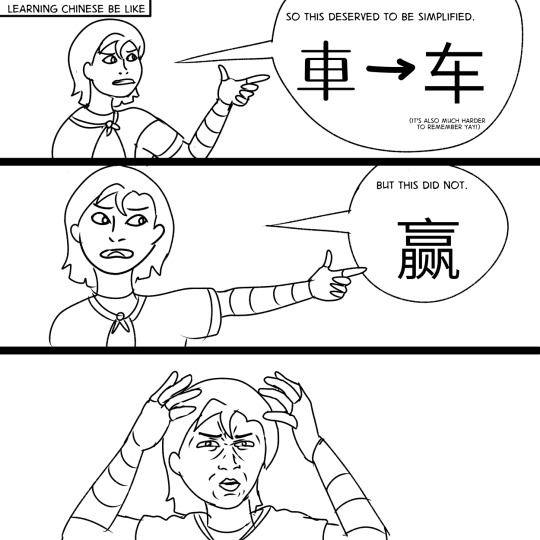
yeeeeep
0 notes
Text


MuzaiPixel is a 8x12px Simplified Chinese pixel font which can be used in retro designs, indie fonts, and so on.
目哉像素是一款 8x12 像素简体中文像素字体,它可以用于复古风设计,独立游戏,等等。
┌在这里下载───┐
0 notes
Text
My new favourite idiom is 画蛇添足 basically meaning to ruin something by overdoing it
Quite literally ‘draw snake add feet’
Pinyin: Huàshé tiānzú
Traditional: 畫蛇添足
4K notes
·
View notes
Photo
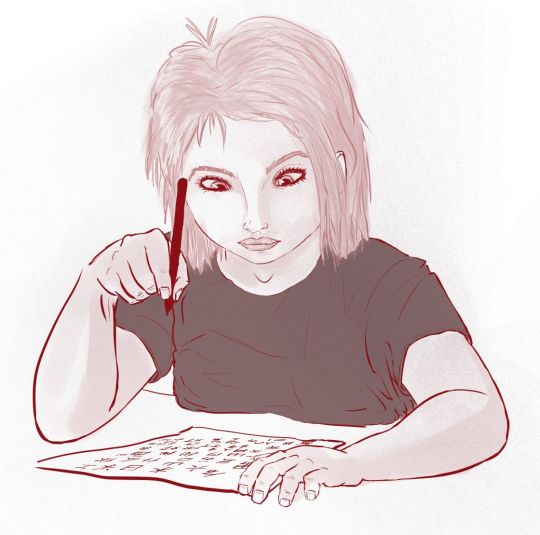
Self Study
#practice#anatomy#face#hands#clothing folds#texture and coloring#simplified chinese#looks a little bit like me but also not really ._.#amehlee art
1 note
·
View note
Text

Title: Graystripe's Vow
Arc: Super Edition
Type: cover
Characters: Graystripe
Country: China
Source: https://warriors.fandom.com/wiki/Graystripe's_Vow?so=search
55 notes
·
View notes
Text
Part of the reason why Cang Qiong accepts Shen Qingqiu's "memory loss" so easily is because the Qing Jing peak lord even forgot how to write...
AKA modern Shen Yuan grew up learning and writing Simplified Chinese so you really can't blame him for struggling with traditional Chinese. He can guess the characters while reading, but writing? Haha... Do you KNOW how many more strokes there are in Traditional Chinese for the same character?!
Let's take doctor as an example: 医生 (simplified) vs 醫生 (traditional)
Heck, some of the differences are minor but it's still a brainfuck: 够 (simplified) vs. 夠 (traditional)
Ming Fang has taken to proofreading and rewriting his shizun's reports before they get sent out to external parties for this reason.
#svsss#svsss ideas#svsss au#shen qingqiu#shen yuan#mxtx#scum villain's self saving system#Shen Yuan writes in simplified chinese; this is a problem when he becomes shen qingqiu AU
619 notes
·
View notes
Text
My new favourite past time is to go to the wikipedia, look for a topic im interested in, and then changing it to chinese
I then obviously add them to a powerpoint like this
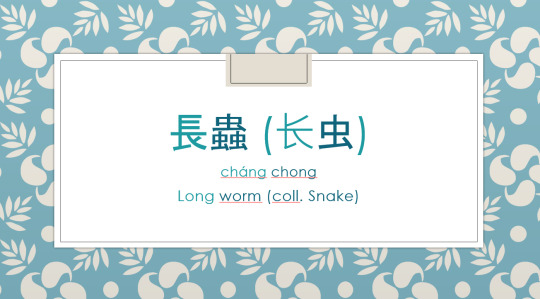
#chinese#chinese langblr#langblr chinese#mandarin langbl#mandarin studyblr#traditional chinese#simplified chinese
2 notes
·
View notes
Text
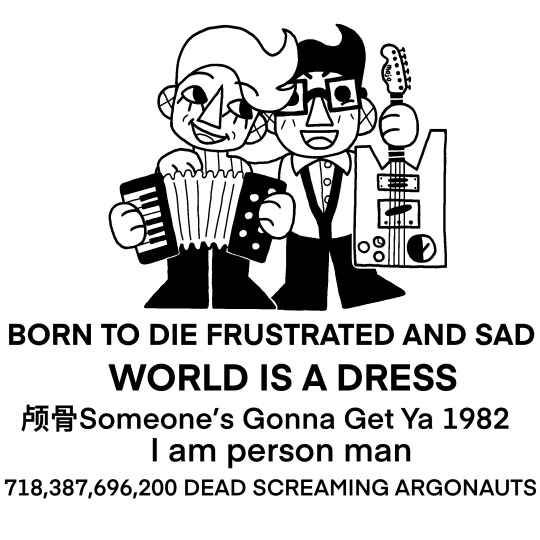
We die alone, we die afraid / we live in terror, we’re naked and alone / and the grave is the loneliest place
original under the cut!!

#The simplified chinese in my version translates to “skull”!!#I had lots of fun recreating this meme!! especially when it came to the references#they might be giants#john linnell#john flansburgh#tmbg#tmbgareok#tmbgposting#my art!!
251 notes
·
View notes
Note
You know Mandarin??
sometime in the spring of this year i kept encountering the idea on other social media that chinese is impossible to learn for europeans, that it's too difficult, that no westerner can learn or truly understand it, and in combination with a mainland friend visiting and telling me the ancient chinese etymology of some basic characters (and the 白人饭 Lunch of Suffering meme) i got fed up/enchanted and did the extremely mentally healthy thing of teaching myself basic mandarin, through about ~april to july. at some points in may i remember coming home from work, scribbling characters in my mandarin notebook over and over, doing chores, going to sleep, and repeating the cycle. a taiwanese friend on here helped out with a lot (it's much, much easier if you have chinese friends to help you, however, i am really not about traditional, although i admit it's more beautiful) and baptized me with a chinese name.
i don't know mandarin, and at this point a lot of the characters i'd learned have faded from memory, but i insist that it's not actually difficult to learn chinese (up to a point— maybe HSK 3 or 4 is where it gets really difficult). in fact, learning chinese is really, really fun.
the difficulty lies in the fact that you have to do it every single day for at least an hour, probably for more (i spent pretty much all my free time on it, but there was something not normal going on with me then). you'd think, isn't that the case for every language? yet i don't remember doing daily french like that, and i consider some aspects of french conjugation/russian grammar much more difficult than what chinese throws at you at similar difficulty levels (good luck with motion verbs, non-slavic speakers). i found learning characters to be very, very easy. they're all distinct. if you learn them together with their etymology, looking at ancient chinese and how they developed along with associated idioms, it's endlessly rewarding. at least in the early levels, there's a bit of a system to how characters and words come together and increase in complexity—sometimes it's funny, sometimes it's cute. it's a breath of fresh air to start reading even basic sentences and idioms in a language so entirely different from anything you've experienced before. many people say speaking chinese is easier than reading/writing: in my experience, that's false. i barely started getting a grasp on the tonal system (my goal was to get to HSK 1 solely through written chinese); i remember listening to the same 2 minute audio clip of two people exchanging phone numbers for half an hour or something once before getting everything right. people say "chinese doesn't have grammar" but that's not true, because otherwise it won't be a language at all, though you don't have to learn any conjugations, declensions, etc. at HSK 1-2 you just throw a modifier/particle into a sentence and you're good to go.
the other main difficulty besides tones is that imo chinese culture is borderline impenetrable if you want to have a genuine stab at it (but for this you don't, necessarily, need to learn mandarin). you can learn HSK 1-2 in a few months or a semester, but it will take you years to genuinely understand the cultural context—there truly is no context clue or familiar idea you can latch on to, as opposed to when learning a european language/history, or even turkish, arabic, persian; there is nothing in common here, and if you guess, you'll probably wind up wrong. it all makes me think of how many journalists/experts get russia wrong: i now firmly do not believe a word of what people write about asia unless i find the author knows the language
anyway

#keep in mind of course i did not go past HSK1#i prefer simplified but seeing what they did to 門 makes one a rabid antimaoist#you get to understand the pò èr shǒu chē reel of the little chinese girl pointing at a porsche that goes around on instagram.#i truly wish china was somehow connected to what i study bc i cannot justify spending that much time on mandarin#unfortunately the harbin russians didn't bother with chinese#smth else about this blog is that india is likewise impenetrable to me. the sheer historical and geographic scale is unbearably intimidatin#where does one even start?#ed* ^ i know the basic 101 historical outlines but i don't think that's “knowing” a place
67 notes
·
View notes